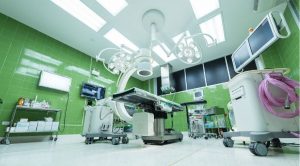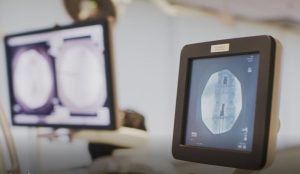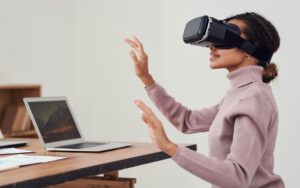In recent years, we’ve seen great strides as companies like Microsoft and TeamViewer introduce and implement its own use cases for AR, which has made attending Las Vegas’ Consumer Electronics Show that much more exciting.
In November, we learned about Utah based biotech company, Zenerchi, an open-source project that has been in the works for decades and led by FanX Salt Lake co-founder Bryan Brandenburg.
With the support from Stanford, MIT, Indiana University, Harvard Medical School, and even the U.S. Department of Defense, Zenerchi and Brandenburg envision a platform that could systematically bring in open-source software to make the human body more accessible to physicians and students for educational purposes.
But what it didn’t expect was COVID-19 to help make the platform more vital than ever. In direct response to the outbreak, Zenerchi was able to catch CBS’ attention after the release of its COVID-19 educational video, whereby the platform was able to create a new level of advanced coronavirus visualizations including the human cell, flu, and what COVID-19 looked like—including its nucleus, proteins, and associated chains and amino acid sequences. Unheard of.
For years, companies have been experimenting with early versions of AR technology to help construct new mechanisms for helping its industry expand and succeed. But the problem with this kind of innovation is that there has been an oversaturation of “AR solutions” that claim to be able to “change the game”. But ask yourself, have any of them really done what they’ve claimed?
What the coronavirus pandemic has done is simply filter the garbage from reality—all pun intended because now is the time to really see if an AR solution really can provide the necessary remote assistance and training it promises.
Since March, Sheba Medical Center in Israel has used five Microsoft HoloLens 2 headsets to train about 60 physicians, biomedical engineers, and nurses on how to operate ventilators for COVID-19 patients. Microsoft’s HoloLens headset uses computer processing and optical projections systems to create digital hologram-like objects that users can see and interact within their real environment.

Back in May, National Bioskills Laboratories, a leading provider of surgical training facilities, unveiled its medical-grade remote physician training platform in response to the travel restrictions COVID-19 placed upon surgeons who traveled for educational purposes or patient consultations. The platform, National Bioskills Live Connect™, combines high-resolution video live streaming from medical devices with real-time, collaborative audio-conferencing capabilities specifically designed for physician skills-training. The solution is capable of streaming multiple video outputs from surgical cameras and medical equipment (such as C-arms or ultrasound machines) simultaneously.
And you better believe this solution was commissioned by board-certified physicians with extensive experience along with the company’s CEO, Douglas A. Hampers.
“We can’t accept lag times, fuzzy images, or unsecured technology,” Dr. Hampers shared with us in a recent interview. “So we designed a medical-grade system to be 100% reliable with razor-sharp images and real-time audio, and top-tier security that is HIPAA compliant.”
And Dr. Hampers isn’t wrong. Healthcare and medical care can’t and shouldn’t stop…even when a global pandemic is upon us. Accessibility to patients is an element to survival that cannot be destroyed, and the way to do it is by advancing AR beyond video games—and instead, focusing on the medical profession and shifting from physical training to virtual care.
But National Bioskills Laboratories isn’t alone in this endeavor. It has the experienced hands of Jon Fisher and his augmented reality firm, CrowdOptic, which uses algorithms and real-time sensor data from electronic devices to enhance security, social media sharing, and advertising.
And if Fisher’s name doesn’t ring a bell to you, he was the visionary behind Bharosa, a leading provider of fraud prevention and authentication-security solutions that was acquired by Oracle for a reported $50 million in 2007; NetClerk, which offered contractors a way to apply for permits online and is now part of Roper Technologies, amongst others.
Fisher’s company’s technology has been implemented in everything from sports to medicine to government. It was also the first patented solution for wearable technologies, such as Google Glass.
Using cloud-based software and proprietary hardware with Intel components from CrowdOptic, National Bioskills Laboratories’ system compresses video files and transmits them securely via enterprise technology protocols for optimized speed, reliability, and scalability, with additional security provided by OneSpan’s Intelligent Adaptive Authentication.

Think of this new AR solution as a portable “plug-and-play”, where all the necessary hardware components are shipped in a small, protective case to anywhere in the world, and can be set up at the host location in less than 20 minutes by non-technical staff. Host users need only a power supply and an internet connection to live stream to remote attendees who log in to a secure web page.
Features of the solution include low latency video/audio live streaming (less than 0.2 seconds), the ability to simulcast streams from any medical equipment with video output, as well as from the included 4K pan-tilt-zoom cameras that can be controlled remotely. It also offers user-friendly options like webcam sharing, screen sharing, annotation, and dial-in phone conferencing. Host companies can stream from as many devices as they need and can hold simultaneous events from different locations.
But if you are still doubtful as to the power AR brings (at least to the medical community), you should check out what John Hopkins accomplished earlier this week. In a first-of-its-kind surgery, John Hopkins performed an AR surgery on a living patient. According to CBS Baltimore, the three neurosurgeons placed six screws in the patient’s spine for spinal fusion surgery by means of a headset with a see-through eye display that projected images of the patient’s internal anatomy—like bones and blood vessels.
Since COVID-19 has taken the world by the heart and soul, the demand for AR solutions which actually provide a benefit to communities has soared. It’s no longer talking the talk, but walking the walk, because guess what? If your company’s AR solution doesn’t work during this time, you’re either out of business or preparing yourself for a lawsuit.
But again, the question presents itself as to why this shift from the physical world of physician training to virtual is industry-changing for when COVID-19 finally is “under control”.
This is just the beginning of a revolutionary change to the way in which medical attention is provided and given, by providing physicians with the tools they need to help communicate the information they need to, directly, in real-time, ensuring colleagues and staff are performing their line of work accurately, safely, and efficiently. Augmented reality is here and now is the chance for it to really be adopted on a mass-scale—and it starts with the medical industry above all others. Forget the video games for now–you don’t see that tech saving lives.










